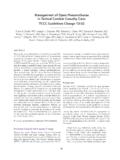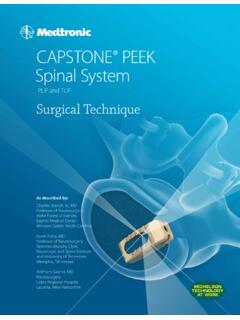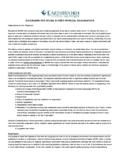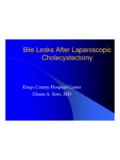Transcription of THE E LING TRA TMNT Minimally Invasive Lumbar ...
1 Southern Academic Press29 JNR 2011; 1(S1): 29-32 IntroductIonThe current treatment algorithm for LSS consists of con-servative management (physical therapy, rest, medica-tions, exercise, etc.), followed by epidural steroid injec-tions (ESI), and finally opens surgical decompression and fusion (Fig. 1). The mild procedure (Vertos Medical) is a Minimally Invasive alternative to open or endoscopic surgery for Lumbar decompression in the treatment of Lumbar spinal stenosis (LSS). mild is typically performed using intravenous (IV) sedation monitored anesthesia care (MAC) and consists of partial removal of inter-lam-inar bone (laminotomy), and partial excision (debulking) of the ipsilateral ligamentum flavum and fatty tissue from the posterior aspect the Lumbar spinal canal. Decompression procedures primarily differ accord-ing to the access and guidance components.
2 For exam-ple, a percutaneous approach is defined by a 5-10 mm surgical incision, an endoscopic approach requires a 15-20 mm incision, and a typical open laminotomy requires a 4-6 cm incision. The mild procedure utilizes a mm portal for percutaneous approach and employs continu-ous epidurographic lateral oblique fluoroscopic image guidance throughout the procedure [2]. MethodsLSS is generally described as compression of the neu-ral elements related to a variety of degenerative changes including: facet hypertrophy, hypertrophic ligamentum flavum, and bulging of the intervertebral disc. In LSS, the space within the spinal canal narrows, which leads to asymptomatic compression of nerves and ultimately symptomatic neurogenic claudication. The goal of any surgical treatment of LSS is relief of symptoms by ad-equate neural decompression while preserving as much of the anatomy, stability, and biomechanics of the lum-bar spine as possible.
3 Endoscopic and traditional open surgical treatment of LSS may not only require the cm incisions mentioned above, but also involve a wide laminectomy and undercutting of the medial facet with fo-raminotomy; leading to local tissue trauma, scarring, and potential postoperative spinal instability [1].The mild procedure offers a Minimally Invasive alter-native to a standard laminotomy-laminectomy. Typically, mild is performed using local anesthesia and IV sedation to keep the patient comfortable. This procedure treats LSS by removing small, but adequate, portions of laminar bone and debulking the ligamentum flavum. The evolving TreaTmenT of Pain Minimally Invasive Lumbar Decompression for Spinal StenosisTimothy R. Deer1, Nagy Mekhail2, Gabriel Lopez3, & Kasra Amirdelfan4 Abstract: Over million patients are diagnosed with, and in active treatment for Lumbar spinal stenosis (LSS) at any given time.
4 Typically, these patients experience discomfort while walking or standing, for any length of time. The LSS treatment algorithm contains a gap of under-treated patients between epidural steroid injections (ESI) and open surgery. With the introduction of a Minimally Invasive Lumbar decompression, or mild , procedure (Vertos Medical) for spinal stenosis, the LSS patient no longer needs to suffer under-treatment or undergo major Lumbar surgery. mild makes it is possible to address this progressive disease with a progressive : Decompression, Lumbar , MiDAS, mild , percutaneous, correspondence to: Timothy R. Deer, , 400 Court Street, Suite 100,Charleston, WV 25301, Telephone (304) 347-6141, Facsimile (304) 347-6855. E-mail: The Center for Pain Relief, Inc., Charleston, WV USA;2 Cleveland Clinic, Pain Management, Cleveland, OH USA;3 Corpus Christi Pain Medicine, Corpus Christi, TX USA;4 IPM Medical Group, Inc.
5 , Walnut Creek, CA 1. Current Treatment Southern Academic Press30 JNR 2011; 1(S1): 29-32 This improves the space in the spinal canal while minimizing trauma to the surrounding tissue and bony structures. The restoration of space is confirmed dur-ing the procedure utilizing the continuous contralateral oblique epidurogram (Fig. 2). Purposeful design elements of the surgical instru-ments used in the mild procedure include built-in safety features such as blunt tips to protect structures at the posterior approach and special top cutting surfaces for precision cutting at the desired angle (Fig. 3). The dis-posable mild kit also includes a portal stabilizer to mini-mize medial and lateral movement during the procedure, and an instrument depth typical mild patient is elderly, often 65 years of age or older, and presents with Lumbar spine neurogenic claudication symptoms thought to be concordant with findings of Lumbar stenosis verified through imaging (MRI or CT) studies.
6 Conservative measures have not allevi-ated symptoms satisfactorily. Neurogenic claudication is triggered by axial loading activities and unlike intermittent or vascular claudication, is relieved by flexion and not by mere cessation of walking as in vascular claudications. Use of a simple standing test or, historically the Van Gel-deren bicycle test, can assist when distinguishing be-tween vascular and neurogenic claudication. The clinical symptoms from LSS result from a constrained cross sec-tional area of the canal either due to direct compression of the nerve roots that comprise the cauda equina, or due to reduction of venous outflow resulting in nerve root ischemia (or some combination of the two). The presence of a hypertrophied ligamentum flavum, compromising the anterior-posterior and lateral dimensions of the spinal ca-nal identifies optimal candidates for the procedure [2, 3].
7 At the beginning of the procedure the patient is placed in the prone position on a radiolucent operating table, draped, and sterilely prepped. Appropriate bol-stering is used as needed (Fig. 4). An epidurogram is then performed for the purpose of identifying the hyper-trophic ligament flavum. Utilization of the contralateral oblique view presents the thickest cross-section of the lamina, providing optimal ligamentum infolding imaging. Next, the interlaminar space is identified through fluo-roscopic visualization (Fig. 5). After the trajectory has been planned and the patient s skin marked, the mild 6G portal and 7G trocar are inserted percutaneously. These devices are advanced along the desired trajectory un-der fluoroscopic guidance. Once positioned, the trocar is removed, leaving the access portal in the interlaminar space (Figs.)
8 6, 7). The mild Bone Sculptor Rongeur is Figure 2. mild Devices: a. mild Tissue Sculpter; b. mild Portal Stabilizer; c. mild Bone Sculpter Rongeur; d. mild Surgical Clamp; e. mild Portal; f. mild Depth Guide; g. mild Trocar and Handle. Figure 3. Epidurogram allows visualization for safe and adequate decompression of the target 4. Patient is kept comfortable in prone position with appropriate bolstering to open interlaminar space exposing target hemilaminar 5. Epidurogram is performed with low volume intermittent injections using flow patterns to determine decompression and stopping Southern Academic Press31 JNR 2011; 1(S1): 29-32placed through the access portal to the lamina. The phy-sician carefully rotates this device, which precisely cuts and then removes small pieces of bone. Once sufficient access is obtained, the Rongeur is removed and the mild Tissue Sculptor is advanced through the portal under the lamina into the dorsal aspect of the hypertrophic liga-mentum flavum.
9 Debulking of the ligamentum flavum is accomplished by removing the collagen laden posterior portion of the ligament, while leaving the ventral fibers of the ligament intact. An improved/easier contrast flow (reduction of infolding), along with limited availability of tissue to be removed, are clear indicators of the decom-pression endpoint on epidurogram. The procedure can be performed bilaterally and on multiple vertebral levels at one or more settings. It should be noted that the angle of the cutting tip on the instrumentation requires a new incision and instrument insertion when the procedure is being performed bilaterally or at another adequate decompression has been achieved at the final operative level, the portal is removed and the wound typically closed with a sterile adhesive bandage.
10 Since there is minimal soft tissue trauma, patients are usually observed for two hours after the procedure (or per facility standard protocol used for light sedation and local anesthetic) and subsequently discharged as clini-cally indicated. Patients are allowed to ambulate as toler-ated and instructed to increase activities slowly. No im-plants are left behind and future treatment is not impeded by the mild EffEctivEnEssThe MiDAS I (mild decompression alternative to open surgery) prospective clinical study was conducted at 14 US spine specialist practices and designed to assess the safety and functional outcomes of mild in the treatment of LSS. Patient selection criteria included: prior failure of conservative therapy; a hyerptrophic ligamentum flavum (> mm); and a reduced thecal sac cross-section.






